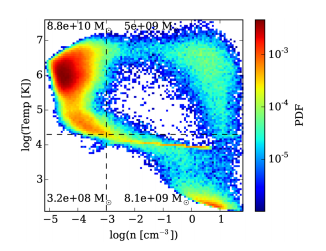How gas evolves, especially gas at temperatures well below a galaxy halo's virial temperature, remains one of the central questions of galaxy formation. The accretion and cooling of gas onto discs makes star formation possible. There are large reservoirs of hot gas surrounding galaxies and centrifugally supported discs of cool gas that form stars. There are a number of physical processes that can move gas between the disk and halo, it seems like the disc gas mass would not stay constant. However, there have been a number of recent steady state models of galaxy formation that suppose exactly that, which present a relatively simple picture of galaxy formation and with such a simple description, they do a remarkably good job reproducing key observables like the evolution of the specific star formation rate. It is thus worthwhile exploring in numerical simulations: Does the assumption of constant gas mass hold?

By with WANG Liang
The Partner group of Purple Mountain Observatory and Max Planck Institute for Astronomy examined the cold gas properties and evolutioin in hydrodynamic simulations of NIHAO project (Wang et al. 2015). In this sample, disc gas mass remain remarkably constant over many Gyrs following their last major merger.
Over a wide range of galaxy masses, the constant cool disk gas mass closely follows to the halo virial mass. The tight relation between halo mass and cool gas mass indicates that there is some sort of universal physical mechanism that determines the cool gas mass. A small experiment that explored how the constant gas mass is affected when various feedbacks are employed find that
feedback does not have a large effect on the constant gas mass. While the gas disc masses are relatively constant, the mass of stars in each simulation vary greatly depending on the specifics of the star formation and feedback recipe, which prompts that how much cool gas exists in the disc should depend sensitively on the interaction between cold, dense gas in the galaxy disc and
the hot diffuse gas in the gaseous halo surrounding galaxies.
This work was published on Monthly Notice of the Royal Astronomical Society. The first author is Greg Stinson, co-authors are Aaron Dutton, Liang Wang, Andrea Maccio, Jakob Herpich, Jeremy Bradford, Tom Quinn, James Wadsley and Ben Keller.
The link of this paper is: http://mnras.oxfordjournals.org/content/454/1/1105
